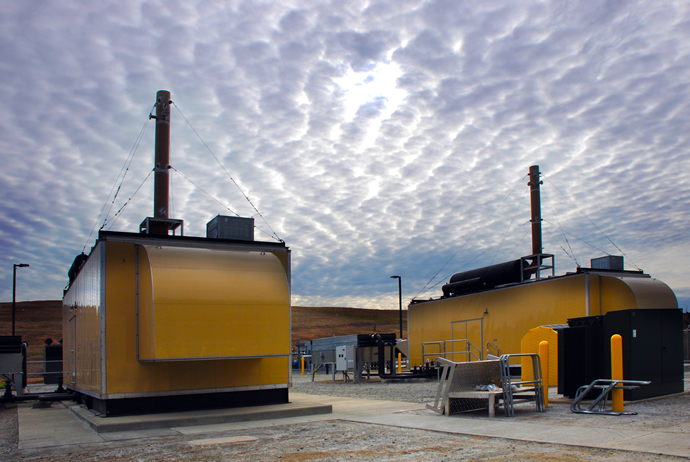It doesn’t have the headline value of a word like “fracking,” but mining methane from landfills has some serious Btu value.
Republic Services announced April 2 its newest landfill gas-to-energy (LFGTE) project located at the Upstate Regional Landfill in Union County, S.C., in the Spartanburg area. The renewable energy project consists of two reciprocating combustion engines that generate 3,200 kilowatts of energy for the local electric grid, or enough electricity to power more than 1,800 area homes.
“Landfills are essential infrastructure in any community, but their value to society goes well beyond disposal,” said Jamey Amick, area president of Republic Services. “Today’s landfill can help to regenerate air, water and land in a local ecosystem, and in many cases it can create a renewable power source from waste decomposition.”
LFGTE projects typically capture methane generated when landfill waste decomposes. Rather than escaping into the atmosphere, the methane can be harnessed and converted into renewable energy to supply the local power grid.
According to the U.S. Environmental Protection Agency (EPA), three megawatts of energy produced from landfill gas is equivalent to preventing carbon emissions generated by the consumption of 16.6 million gallons of gasoline. Based on EPA methodology, the carbon emissions prevented by the Upstate Regional LFGTE project from entering the air is equivalent to the consumption of roughly 900,000 gallons of gasoline each year.
Republic Services of South Carolina — which employs 115 people who serve more than 4,500 commercial, industrial, and municipal customers throughout nine counties in Upstate South Carolina — partnered with Lockhart Bioenergy, LLC, an affiliate of Lockhart Power Co. and Pacolet Milliken Enterprises, Inc., to develop the Upstate Regional LFGTE project. Lockhart Bioenergy will operate the plant. The energy output is being purchased by Duke Energy.
“We are pleased to bring another renewable energy facility to South Carolina,” said Bryan Stone, COO at Lockhart Power. “The facility not only generates renewable clean energy for customers in Union County and surrounding areas, but it’s also a great economic development tool for attracting industries tailored for green initiatives to our area.”
Republic Services and its subsidiaries operate 73 LFGTE projects nationwide. Others include County Line in Argos, Idaho (operated with Aria Energy); Sunshine Canyon in Sylmar, Calif. (with Aria and DTE Biomass); the Vasco and Forward landfills in Manteca, Calif. (with Ameresco); and National Serv-All in Fort Wayne, Ind. (with Toro Energy).
Vast Potential
According to the US EPA, creative use of landfill gas (LFG) includes heating greenhouses, producing electricity and heat in cogeneration applications, firing brick kilns, supplying high–Btu pipeline-quality gas, fueling garbage trucks, and providing fuel to chemical and automobile manufacturing. The hundreds of projects currently in operation across the nation range from small–scale community–driven initiatives to multi–million–dollar private investments.
The EPA’s Landfill Methane Outreach Program (LMOP) just updated its inventory of LFG projects nationwide and by state. As of March 4, there are 645 operational LFG projects in the United States, and another 440 candidate sites, meaning a landfill is accepting waste or has been closed for five years or less, has at least 1 million tons of waste, and does not have an operational, under-construction, or planned project; can also be designated based on actual interest by the site. Other status categories include shutdown, under construction, planned and potential, meaning not all data has been collected.
Examining the data highlights territories that lead either because their legacy of landfill waste management is long, their policies toward harvesting energy from them is progressive, or some combination of the two.
As the map below indicates, California leads the way in terms of operational LFG projects, with 78, followed by Michigan and North Carolina with 42 each, North Carolina with 34, Illinois with 33, Virginia with 32, New York with 30 and Wisconsin with 29.
Of the 2,954 landfills in the LMOP database (in all status categories), 380 of them — nearly 13 percent — are in California, making the Golden State the far-and-away leader in landfill gas projects.
Second place goes to North Carolina, with 145 total projects. Tennessee and Texas, each have 137. New York has 122, Pennsylvania 120. Indiana and Missouri each have 114 projects being tracked by LMOP. Illinois has 109, and Michigan has 99.
A total of 1,094 of the LMOP projects are privately owned, many of them owned by the major service providers such as Republic (282) and Waste Management (340). And some are related to legacy industrial plants, such as 3M’s landfill near its plant in Nevada, Mo., and small California landfills owned by Owens Corning and Louisiana-Pacific.
Where are the biggest landfills? The closed facilities at Puente Hills in Los Angeles and Fresh Kills on Staten Island both have well over 100 million tons of waste to mine. Multiple projects at Puente Hills are collecting 45 million standard cubic ft of gas per day (mmscfd), while Fresh Kills is collecting just over 6.5 mmscfd on several projects itself.
Puente Hills has the highest MW capacity in the nation, at 50 MW, followed by Central Landfill in Providence, R.I. (32 MW); and Arbor Hills Landfill in Northville, Mich. (23.5 MW).
LMOP, living up to its name, has extended its outreach beyond US borders as well, including model projects in China, Colombia, Mexico, Philippines and Ukraine. The separate Global Methane Initiative has tracked more than 2,000 non-US projects from sources including the oil & gas, coal mining and agriculture sectors, as well as wastewater and municipal solid waste.
According to LMOP, a total of 19 new LFG projects are were under construction as of March, including the Advanced Disposal Orchard Hills project in Ogle County, Ill., where Hoosier Energy will begin off-taking power in early 2016.
Of the 2,400 or so currently operating or recently closed MSW landfills in the United States, about 595 have LFG utilization projects. EPA estimates that approximately 440 additional MSW landfills could turn their gas into energy, producing enough electricity to power nearly 512,000 homes.

